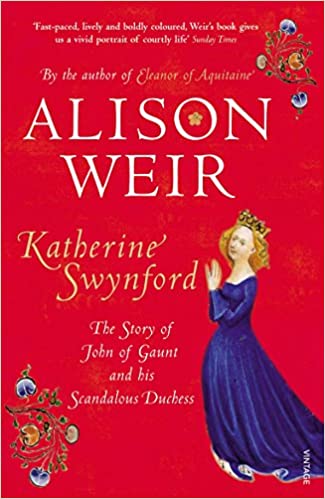
Let’s be honest: lockdown sucks! But it does mean there’s more time for reading. Over the next couple of weeks, I will review 10 books which all Royal History Geeks should add to their reading list.
Getting into the head of today’s public figures is tough enough. You might well have a strong opinion about the Duchess of Cornwall or Cherie Blair only to meet them and be utterly surprised.
So attempting to reconstruct the life of an obscure 14th century woman is an ambitious challenge. Especially when source material is scant and what we do have is highly biased.
Thankfully, it’s a challenge that Alison Weir rises to with robust research and inspired imagination.
‘Katherine Swynford: the story of John of Gaunt and his scandalous duchess’ is the kind of masterpiece that demonstrates exactly why Weir is one of the world’s best-selling historians. The author pieces together fragments of source material and weaves them into the tapestry of history. With Weir’s gift of empathy, the reader is left with little doubt as to why Katherine was a woman who captured the heart of a prince and aroused the suspicions of a nation.
The book begins with Sywnford’s arrival in England at around the age of two. It follows her early life and first marriage. It shows how the life of Katherine and her husband Hugh became entangled with the Lancastrian court.
As the book’s sub-heading suggests, the narrative also explores the story of John of Gaunt. By using sources such as Chaucer’s poetry, Weir paints a picture of Gaunt’s first marriage to Blanche of Lancaster. She brings to life the grief he almost certainly felt at her untimely death.
Gaunt and Swynford’s relationship almost certainly begins after the couple are respectively widowed. Gaunt, however, had embarked on a second marriage. The author uses compelling evidence to disprove later claims that their children were conceived in ‘double adultery.’ Using records of grants made to Katherine from John, the author credible speculates as to the date of birth of each of the four Beaufort children, while recognising the limitations of the exercise.
This book is not a photograph. It’s an artist’s impression. And Alison Weir is quite the painter. By detailing what we know of Kettlethorpe manor and great houses Katherine lived in we get a sense as to what daily life might have looked like. No sources mention her intellect or character. But Weir shrewdly deduces that her appointment as governess to the Lancastrian princesses suggests she was both clever and sophisticated. Above all else, the author rescues Katherine from the reputation dished upon her by monkish chroniclers.
Some commentators have been critical of this presentation of history. If the facts of what we know of someone’s life can fit on the back cover, is it appropriate to attempt a full biography? But I defy anyone to read this work and not deem it a useful exercise.
Intelligent speculation may have its limits. But with Weir’s gifts of empathy, her thorough research and knowledge of the era, one of history’s most elusive figures can finally step into the spotlight and enjoy a measure of the attention she deserves.
Katherine Swynford: The Story of John of Gaunt and His Scandalous Duchess is available from Amazon.
However, please consider supporting your local book seller. If you are based in the UK, search for your local book seller at the Book Seller Associations website.
Subscribe to our newsletter!